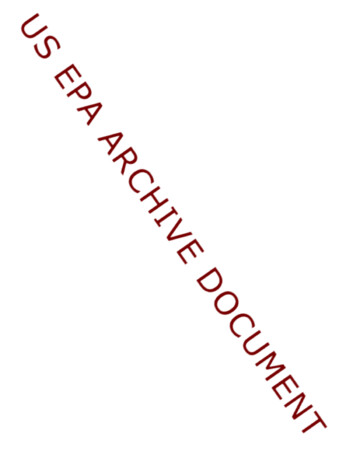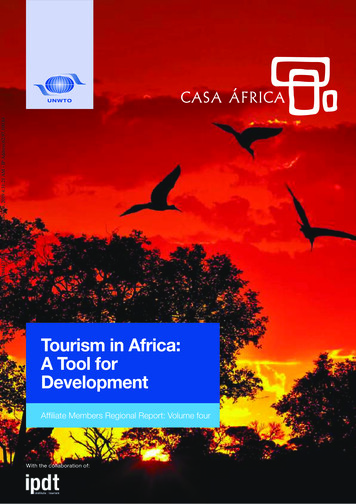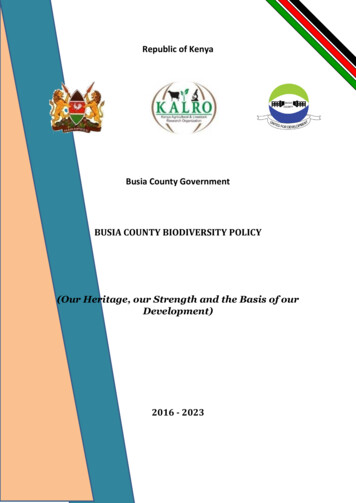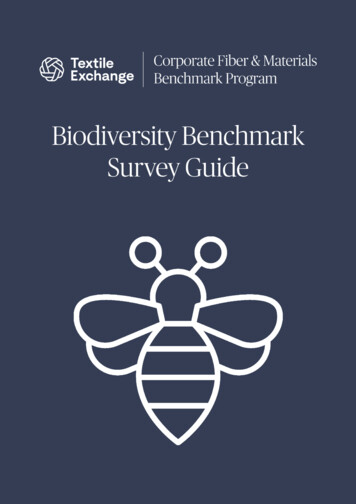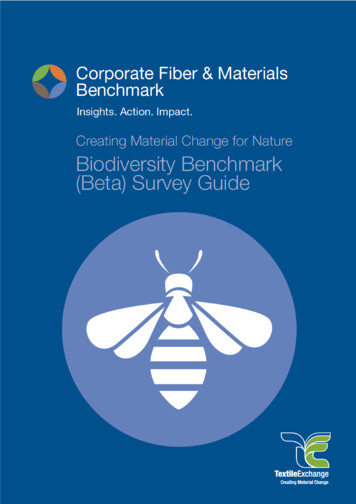
Transcription
WEST AFRICA BIODIVERSITY AND CLIMATECHANGE (WA BiCC)Review of Coastal Adaptation Practices inDeveloping Countries(April 2020)
This work was conducted under the USAID-funded West Africa Biodiversity and Climate Change (WABiCC) project. The report was prepared by the Center for International Earth Science InformationNetwork (CIESIN) of the Earth Institute of Columbia University under contract with Tetra Tech.This publication was produced for the United States Agency for International Development by TetraTech ARD, through a Task Order under the Prosperity, Livelihoods, and Conserving Ecosystems(PLACE) Indefinite Quantity Contract Core Task Order (USAID Contract No. AID-EPP-I-00-06-00008,Order Number AID-OAA-TO-11-00064).For more information on the West Africa Biodiversity and Climate Change program, contact:USAID/West Africa Biodiversity and Climate ChangeTetra Tech2nd Labone Link, North LaboneAccra, GhanaTel: 233(0)302 788 600Email: www.tetratech.com/intdevWebsite: www.wabicc.orgStephen KelleherChief of PartyAccra, GhanaTel: 233 (0) 302 788 600Email: Stephen.Kelleher@wabicc.orgVaneska LitzProject ManagerBurlington, VermontTel: 1. 802.495.0303Email: Vaneska.Litz@tetratech.comCitation:Trzaska, S., E. Boytinck, A. de Sherbinin, S. Smith, and Anne-Laure White. (2020).Review of coastal adaptation practices in developing countries. Report published undercontract with Tetra Tech for the USAID West Africa Biodiversity and ClimateChange (WA BiCC) project.Cover Photo:The village of Moable, Sierra Leone, July 2016. Credit: S. Trzaska
TABLE OF CONTENTSEXECUTIVE SUMMARY.III1.0INTRODUCTION . 12.0METHODOLOGY . 23.04.02.1PROJECT SELECTION AND OVERALL APPROACH TO EVALUATION . 22.2OVERVIEW OF THE PROJECTS EVALUATED . 22.3OVERVIEW OF COASTAL CLIMATE ADAPTATION ACTIVITIES . 62.4SELECTION OF CRITERIA AND EVALUATION METHOD . 92.5CAVEATS . 11MAIN RESULTS . 123.1OVERALL RANKINGS . 123.2REGIONAL ANALYSIS . 133.3BUDGET ANALYSIS . 143.4ANALYSIS BY STATUS . 153.5CRITERION FULFILLMENT . 16DETAILED ANALYSIS BY PRACTICE . 194.1RISK, VULNERABILITY, AND CAPACITY . 194.1.14.1.24.1.34.2PARTICIPATION, INCLUSION, GENDER EQUALITY. 214.2.14.2.24.2.34.3CRITERIA FOR EVALUATION. 22RANKINGS . 23REGIONAL ANALYSIS . 24PLANNING AND DECISION-MAKING PROCESSES. 244.4.14.4.24.4.34.5CRITERIA FOR EVALUATION. 21RANKINGS . 21REGIONAL ANALYSIS . 22CLIMATE INFORMATION, UNCERTAINTY . 224.3.14.3.24.3.34.4CRITERIA FOR EVALUATION. 19RANKINGS . 20REGIONAL ANALYSIS . 20CRITERIA FOR EVALUATION. 24RANKINGS . 25REGIONAL ANALYSIS . 26INNOVATION, LOCAL KNOWLEDGE, TECHNOLOGY . 264.5.14.5.2CRITERIA FOR EVALUATION. 26RANKINGS . 27WA BICC: REVIEW OF COASTAL ADAPTATION PRACTICES IN DEVELOPING COUNTRIESi
4.5.34.6ADAPTIVE MANAGEMENT . 284.6.14.6.24.6.34.7REGIONAL ANALYSIS . 28CRITERIA FOR EVALUATION. 28RANKINGS . 29REGIONAL ANALYSIS . 30INSTITUTIONAL LINKAGES . 304.7.14.7.24.7.3CRITERIA FOR EVALUATION. 30RANKINGS . 31REGIONAL ANALYSIS . 324.8 PRACTICE 8: LEARNING, CAPACITY BUILDING, KNOWLEDGEMANAGEMENT . 324.8.14.8.24.8.34.9SCALING UP AND SUSTAINABILITY. 344.9.14.9.24.9.35.0CRITERIA FOR EVALUATION. 32RANKINGS . 33REGIONAL ANALYSIS . 34CRITERIA FOR EVALUATION. 34RANKINGS . 35REGIONAL ANALYSIS . 36WA BICC COASTAL ADAPTATION ACTIVITIES . 375.1INTRODUCTION TO THE WA BICC PROGRAM. 375.1.15.1.25.1.35.2THE SIERRA LEONE COASTAL LANDSCAPE COMPLEX (SLCLC)PROJECT . 425.2.15.2.25.2.35.2.45.3OBJECTIVES . 37WA BICC THEORY OF CHANGE . 37WA BICC’S COASTAL ADAPTATION WORK. 37PROJECT DESCRIPTION. 42MAJOR ACHIEVEMENTS. 48ASPECTS THAT CONFORM TO GOOD PRACTICES . 49CHALLENGES AND LESSONS LEARNED. 50FRESCO COASTAL LANDSCAPE PROJECT . 505.3.15.3.25.3.35.3.4PROJECT DESCRIPTION. 50MAJOR ACHIEVEMENTS. 51ASPECTS THAT CONFORM TO GOOD PRACTICES . 54CHALLENGES AND LESSONS LEARNED. 566.0SUMMARY AND CONCLUSIONS . 577.0REFERENCES . 60ANNEX 1. STATED GOALS OF EACH PROJECT . 64WA BICC: REVIEW OF COASTAL ADAPTATION PRACTICES IN DEVELOPING COUNTRIESii
EXECUTIVE SUMMARYThis report reviews best practices in coastal adaptation in developing countries. The review analyzesend-of-project and mid-term evaluations of 17 coastal adaptation projects from tropical regions inAfrica, Asia and Pacific, and Latin America and the Caribbean performed by entities independent ofimplementing and funding agencies. It also reviews climate adaptation work of the West AfricaBiodiversity and Climate Change (WA BiCC) project in two coastal “learning landscapes”.The projects reviewed in this report cover coastal adaptation activities that can be grouped into sevenbroad categories:1.2.3.4.5.6.7.Agriculture and FisheriesCoastal DefensesEcosystem rehabilitationAlerts, Education & CommunicationTransportationWaste managementWater securityThe sample represents the range of activities undertaken in most developing countries (see section 2.3for examples). Note, however, that none of the projects focused on relocation of households orsettlements, but instead they addressed protection measures that in theory will help communities toremain in place. This could be potentially tied to the overall reluctance of the populations to relocate, ashighlighted in one of the projects. However, investigation of future and current projects for whichevaluations are not yet available indicates that relocation may be more widely implemented in morerecent projects.In order to evaluate and compare a wide variety of projects with various objectives and designs, theanalysis used a comprehensive set of 37 criteria stemming from nine practices identified by “TheAdaptation Good Practices Checklist”, compiled by Care International with input from a wide array ofinstitutions and experts specializing in adaptation. Those practices fall in the following categories:1. Risk, vulnerability and capacity;2. Participation, inclusion and gender;3. Climate information and uncertainty;4. Planning and decision-making processes;5. Innovation, local and indigenous knowledge and technology;6. Adaptive management;7. Institutional linkages;8. Learning, capacity building and knowledge management, and9. Scaling up and sustainability.Coastal adaptation projects were evaluated based on the degree to which each of the criteria werefulfilled, using a three-point scale to guide a subjective evaluation and facilitate a comparative analysis ofall projects.WA BICC: REVIEW OF COASTAL ADAPTATION PRACTICES IN DEVELOPING COUNTRIESiii
MAIN RESULTSIndividual projects implemented between 1 and 5 activities, as defined by the categories above.Ecosystem-based adaptation and Alerts, Education & Communication were the most commonlyimplemented activities (in 14 out of 17 projects) while Coastal Defenses, Waste management andTransportation were implemented in fewer than one third of the projects.No project achieved a maximum score on all practices/criteria. Best performing projects obtainedmaximum scores in four practices, but most projects satisfactorily implemented only one or twopractices. Projects in the lowest tier of the scale did not obtain a maximum score on any of thepractices. Similarly, no practice was addressed in a satisfactory way across all the projects. Practice ‘Risk,vulnerability and capacity’ was the best implemented of all practices, but even for this practice only fourprojects received the maximum score. Most practices were well implemented in two projects at most.This highlights the breadth of focuses and approaches of projects in coastal adaptation and the lack of awell-established set of practices, common to all projects. With this in mind the overall best performingprojects according to the set of criteria used here were:1. Haiti - Strengthening Adaptive Capacities to Address Climate Change Threats on SustainableDevelopment Strategies for Coastal Communities in Haiti implemented by the UNDP under theGlobal Environmental Facility (GEF). This project focused on development of Agriculture andFisheries, Alerts, Education & Communication, Water Security and Ecosystem-based adaptationactivities.2. Sao Tome - Adaptation to Climate Change implemented by the World Bank under the GEF. Thisproject focused on Coastal Defenses and Alerts, Education & Communication activities.3. Cuba - Reduction of Environmental Vulnerability implemented by UNDP under the GEF. Theproject was exclusively devoted to Ecosystem-based adaptation.The lowest ranking projects were located in Tuvalu, Bangladesh and Mozambique and focusedrespectively on four to five among all the activity categories.There was no relationship between the type or the number of activities and overall practice ranking –neither implementing a more comprehensive set of activities nor focusing on fewer activities did lead tobetter outcomes in terms of adaptation practices.Certain practices or individual criteria/activities in this evaluation seem to be well internalized andimplemented across the projects while a few activities were systematically under-implemented. Activitiesrelated to participatory aspects, inclusion and diversity, feedback loops and flexible planning seem tohave been less well implemented in majority of the projects. Best-performing projects usually addressedthese activities better than the other projects while preforming similarly in the other, betterimplemented areas.SUMMARY CONCLUSIONSThe main conclusions by practice are:1. Risk/Vulnerability and capacity – These criteria were generally well addressed. Projects thatperformed particularly well in this category required implementers to undertake comprehensiveassessments to understand the social, ecological, and economic factors underpinning vulnerability.WA BICC: REVIEW OF COASTAL ADAPTATION PRACTICES IN DEVELOPING COUNTRIESiv
2.3.4.5.6.7.8.They had a detailed understanding of the needs of different stakeholders before project design evenbegan. Best performing projects in this practice were located in Cambodia, Guinea, Haiti andSamoa.The participation, inclusion, and gender equality practice had the most “partially fulfilled” score butalso a high percentage of projects not addressing them at all. Projects that performed well in thispractice devoted time and effort to create highly participatory practices with an explicit genderfocus that went beyond the inclusion of women and towards a feminist implementation. In addition,projects designed policies that were pro-poor and considered wealth variations in their targetcommunities, rather than treating the community as a monolithic group. Top-scoring projects in thiscategory were located in Mexico and Thailand.Climate Information-related criteria were poorly addressed. This highlights the fact that coastaladaptation projects focused mostly on addressing the adverse effects of climate change impacts anddid not include the reinforcement of climate services or capacity building of communities. Projectsthat performed well in this practice supported Meteorological Services and provided comprehensivetraining to build the capacity of local actors for the ongoing creation, interpretation, anddissemination of climate information. Some projects created risk reports that could be sent out tofishermen or farmers in an accessible way. Best performing projects in this practice were located inSao Tome and Haiti.Planning and decision-making practice showed a contrasting picture, with some criteria wellimplemented (appropriate planning level and identification of options) but others remaining poorlyaddressed (flexible planning and screening processes). Projects that performed well here hadflexible plans and budgets that allowed them to adapt to a local and changing context. They oftenintegrated their projects into the national development plans and worked closely with governmentsat multiple levels. Adaptation options were selected through a clear screening process. The bestprojects in this practice were located in Sao Tome and Haiti.Innovation, local knowledge, and technology practice were generally well accounted for,except the use of local and indigenous knowledge and technologies. Projects that performed wellimplemented traditional forms of knowledge into the design, focusing specifically on innovations thathad a good chance of replication and building the capacity for communities to use these technologiesequitably in the long term. They also partnered with local universities. Best projects were located inThailand and Cuba.Adaptive management had a very split performance between the criteria, with most of theprojects failing to include social and environmental safeguards. Projects that performed well hereavoided maladaptation by setting clear social and environmental safeguards that were respected indesign. They did not predetermine all the activities during preparation, thus allowing for flexibility toadapt to the expressed needs and actual capacities of local communities. Best projects were locatedin the Caribbean and Sao Tome.Institutional linkages were in general well incorporated in most of the projects. Projects thatperformed well created multi-stakeholder forums that included representatives from the public andprivate sectors, as well as civil society groups and NGOs. They also prioritized inter-ministrycooperation on the multi-sectoral aspects of climate change. Highest scoring projects were locatedin Senegal and Haiti.Learning, capacity building, knowledge management criteria had high variability in theirperformance. While most of the projects did well in the M&E and capacity building theWA BICC: REVIEW OF COASTAL ADAPTATION PRACTICES IN DEVELOPING COUNTRIESv
implementation of continuous reflection and feedback loops and related resource allocation werenot implemented in most of the projects. Projects that performed well benefited from lessonslearned in other relevant projects operating in similar environments and created community-basedM&E structures that informed decision-making processes within the projects. Monitoring systemswere robust and used for project improvement, rather than simply for reporting. Best performers inthis practice were located in Sao Tome and Tanzania. The WA BiCC project (Section 5) isnotable in its use of learning to inform policy and practice.9. Scaling up and sustainability practice was in general well addressed, except the cost-benefitanalysis, nonexistent in most projects. Projects that performed well in considerations built localcapacity and ownership at both local and national levels, including both top-down and bottom-upapproaches. They also included a cost-benefit analysis in their project design to ensure projectsustainability. Caribbean, Cuba and Samoa were the best performers.RECOMMENDATIONSWhether implementing a wide array of adaptation activities or having a narrow focus, coastal adaptationprojects could benefit from improved participation of communities and stakeholders at all stages of theproject, beyond the design, and from flexible project implementation. This could potentially lead toimproved responsiveness of the projects to local needs and insure improved sustainability and overalloutcomes. Such activities would need to be planned in the design phase of the project and “TheAdaptation Good Practices Checklist” could be a good resource to ensure that all the aspects of goodpractices in adaptation are taken into account. Coastal adaptation projects could also improve their useof climate information as an adaptation tool.WA BICC: REVIEW OF COASTAL ADAPTATION PRACTICES IN DEVELOPING COUNTRIESvi
1.0INTRODUCTIONThe West African Biodiversity and Climate Change (WA BiCC) project’s second component focuses onbuilding resilience of coastal areas of West Africa. The coastal zone is home to about one-third of theregion’s population, with an annual growth rate of about four percent (de Sherbinin et al. 2014). A verylarge proportion, about 42%, of West Africa’s GDP is generated from its coastal areas. More than 1.6million tons of fish are legally captured in West African waters each year, with an estimated wholesalevalue of US 2.5 billion. The coast hosts major cities, ports, agro-industries, fisheries, and offshorepetroleum exploration and production. Its high population growth rates reflect its economic vibrancyand attractiveness.Climate change will exacerbate existing physical, ecological/biological, and socioeconomic stresses onthe African coastal zone. Many coastal nations of West and Central Africa have low-lying coasts that aresusceptible to erosion and hence are threatened by sea level rise, additionally exacerbated by potentialrise in storminess, leading to increased frequency of impactful storm surges and extreme wind events.Populations living in these areas will be impacted in two ways: through the potential loss of habitablearea due to land loss and salinization; and through impact on their livelihoods since changes intemperature and rainfall patterns will affect fisheries upon which coastal communities rely.Adaptation is ongoing in many coastal areas of the tropics, whether through locally led initiatives,government projects, or donor driven activities. Given the number of projects, it is important to takestock of on-going activities to inform future projects. This report is an attempt to identify projects incoastal areas in the tropics that addressed the various aspects of adaptation to climate change. It isbased on a desk study of end-of-project and mid-term evaluation and as such presents the major caveatof not being able to assess the sustainability and longer-term outcomes of the projects in the field. Theauthors hope, however, that it is a useful first step in identifying current best practices in project designand implementation that can be useful for future projects.The report is structured as follows: Section 2 describes the overall approach, project selection anddescription of the coastal climate adaptation activities undertaken by each of the projects and evaluationmethodology. Section 3 gives an overview of the main results in their aggregated form while section 4details the results by practice. Section 5 describes WA BiCC coastal adaptation activities, and Section 6summarises the results.WA BICC: REVIEW OF COASTAL ADAPTATION PRACTICES IN DEVELOPING COUNTRIES1
2.02.1METHODOLOGYPROJECT SELECTION AND OVERALL APPROACH TO EVALUATIONThis report is based on a desk review of project-related documents available on-line. The initial intentwas to review both peer-reviewed and grey literature, but the number of peer-reviewed articles oncoastal adaptation projects was small. Thus, this analysis only reviewed projects available throughdatabases of organizations such as United Nations Development Program (UNDP) and the World Bank,as well as the Global Environmental Facility (GEF), the Adaptation Fund, and the Green Climate Fund.While some projects had significant documentation, the degree to which a project could be evaluatedbased on the documentation provided varied greatly, from final evaluations to mid-term evaluations toproject proposal documents. The latter, often referred to as “Prodocs”, were not included in the finalanalysis as they did not provide any assessments of what was actually implemented. Only terminal andmid-term evaluations, carried out independently from the funding and/or implementing agencies wereconsidered as they allowed us to understand both what the projects set out to achieve and what theyactually did achieve with some objectivity. The projects selected are described in the next sub-section; alist of projects can be found in Table 1. The activities implemented under each project are detailed insection 2.3 and a summary by project is included in table2.Evaluation criteria for this wide array of projects with different scopes and approaches to projectimplementation needed to be comprehensive to accommodate the diversity. After research, “TheAdaptation Good Practices Checklist”, published by the CARE Climate Change & Resilience InformationCentre in 2016 (CARE 2016), was chosen as it was compiled to guide the design and implementation ofclimate change adaptation projects. The criteria were derived through an analysis of the UNFCCC ParisAgreement and a range of adaptation approaches, reflecting previously published work of a similarnature. Several research and policy institutions, including the CGIAR Climate Change Agriculture andFood Security programme (CCAFS), the Climate Change Directorate of the Ministry of Environmentand Natural Resources in Kenya, the Africa Centre for Technology Studies (ACTs), the Pan AfricanClimate Justice Alliance (PACJA), the Climate and Development Knowledge Network (CDKN), theInternational Research Institute for Climate and Society (IRI) of Columbia University, and the WorldResources Institute (WRI), were actively involved in the development and testing of the AdaptationGood Practices Checklist. Given the involvement of multiple global stakeholders and the extensivenature of the criteria, the Adaptation Good Practices Checklist was deemed comprehensive and suitablefor our purposes. The details of the criteria are presented in section 2.4.2.2OVERVIEW OF THE PROJECTS EVALUATEDIn total, 17 coastal adaptation projects were included in the analysis, 12 through their terminalevaluations and 5 through their midterm evaluations.WA BICC: REVIEW OF COASTAL ADAPTATION PRACTICES IN DEVELOPING COUNTRIES2
Projects budgets ranged from 1.7 million to 13.7 million, with an average of 6.1 million. The averagecompleted project length was 5.3 years, with a minimum duration of 3 years and a maximum of 8 years.Of projects evaluated, 8 were from Africa, 5 were from Asia and the Pacific, and 4 were from LatinAmerica and the Caribbean.Projects by regionAverage budget per aAfricaAsia PacificAsia PacificLatin America CaribbeanLatin America CaribbeanFIGURE 1: DISTRIBUTION OF PROJECTS BY REGION AND AVERAGE PROJECTBUDGET BY REGION.An overview of projects examined in the final analysis is present in Table 1.The details and links to the projects on the internet are provided in the reference list.WA BICC: REVIEW OF COASTAL ADAPTATION PRACTICES IN DEVELOPING COUNTRIES3
TABLE 1: SUMMARY OF THE PRINCIPAL CHARACTERISTICS OF THE PROJECTS SELECTED FOR THIS REPORT,INCLUDING: PROJECT TITLE, COUNTRY OF IMPLEMENTATION, REGION, FUNDING OR IMPLEMENTING AGENCY,PROJECT BUDGET AND DURATION, TYPE OF DOCUMENT SUPPORTING THE ASSESSMENT, PROJECT CODE USEDIN THIS REPORT.Project TitleCountryRegionImplementing AgencyStatusAdaptation in the Coastal Zones of et(USD)1703416Implementing NAPA priority interventions to buildresilience in the most vulnerable coastal zones inDjiboutiSao Tome - Adaptation to Climate ChangeDjiboutiAfricaUNEPCompleted1880646Sao Tomeand PrincipeAfricaCompletedAdaptation to coastal erosion in vulnerable areasSenegalAfricaMARAPA, Dir. Geral doAmbiente, CONPREC, InstituteNacional da meteorologia, Dir.das PescaCentre for Ecological MonitoringIncreased Resilience and Adaptation to Adverse Impactsof Climate Change in Guinea's Vulnerable Coastal ZonesResponding to Coastal Climate Change and Its HumanDimensions in West AfricaImplementation of concrete adaptation measures toreduce vulnerability of livelihoods and economy ofcoastal communities of TanzaniaClimate Change Adaptation Programme in the CoastalZone of MauritiusVulnerability Assessment and Adaptation Project forClimate Change in the Coastal Zone of CambodiaIncreasing Resilience of Coastal Areas and CommunitySettlements to Climate Change in TuvaluStrengthening the Capacity of Vulnerable CoastalCommunities to Address the Risk of Climate Changeand Extreme Weather EventsCommunity Based Adaptation to Climate Changethrough Coastal Afforestation in BangladeshEnhancing resilience of coastal communities of Samoa toclimate changeAdaptation to Climate Change Impacts on the CoastalWetlands in the Gulf of MexicoGuineaAfricaWest alSenUNDPCompleted42965585TerminalGuiAfricaUNDP/ id-term91192400Mid-termMauCambodia
This report reviews best practices in coastal adaptation in developing countries. The review analyzes end-of-project and mid-term evaluations of 17 coastal adaptation projects from tropical regions in Africa, Asia and Pacific, and Latin America and the Caribbean performed by entities independent of implementing and funding agencies. It also reviews climate adaptation work of the West Africa .

